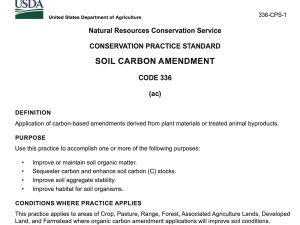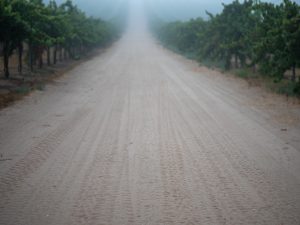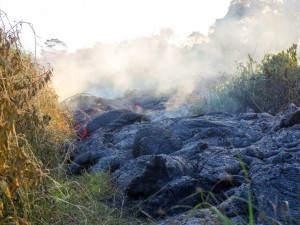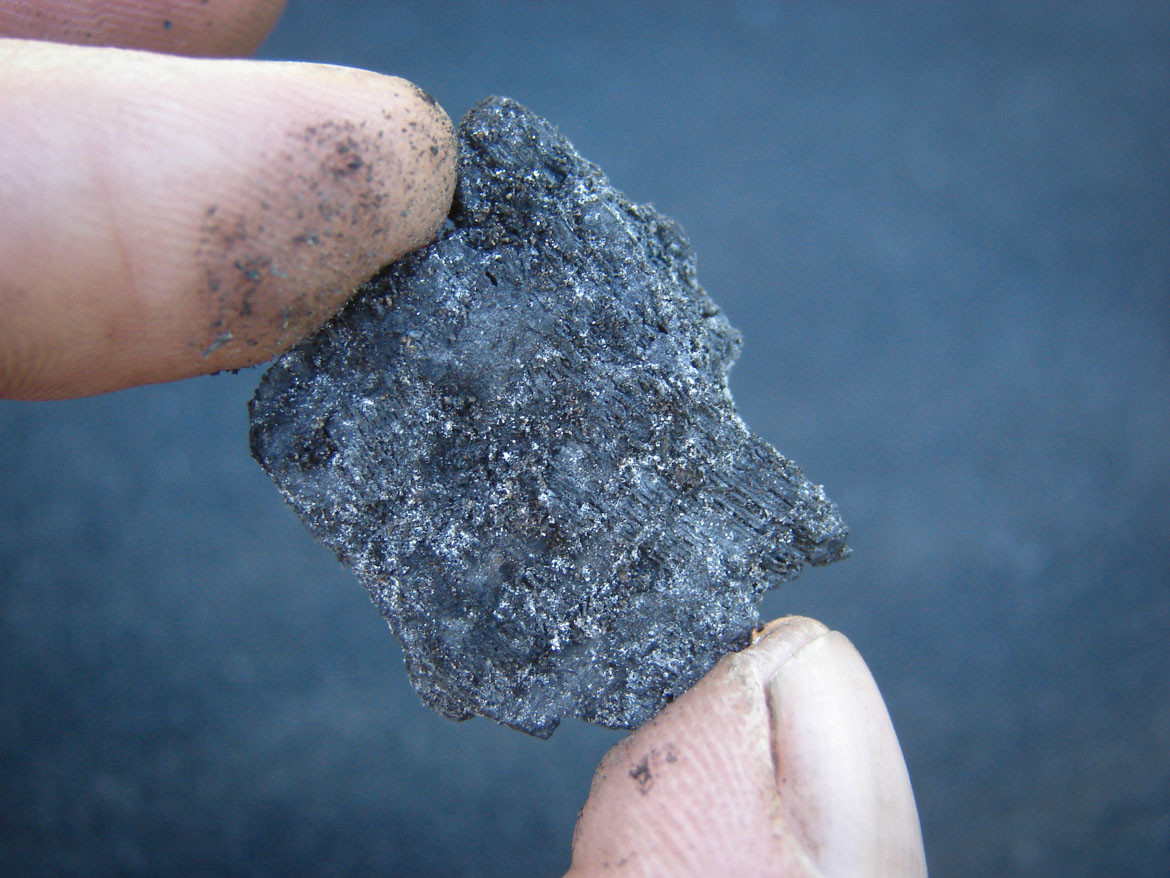
Hello, Josiah Hunt here with a few words on our biological activation process to improve biochar materials for use in soil.
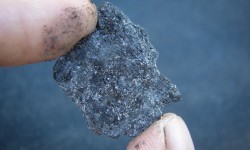
“Inoculated Biochar” A photo of biochar visibly covered in living organisms. Josiah Hunt, 2009
At Pacific Biochar, we provide biochar Products that are not just blended, they are improved in our personally developed biological activation process. In this post I will tell you how the process was discovered, how the understanding and recipes have evolved, and specifically how the characteristics of the biochar materials are improved for use as a soil amendment. In the paragraphs that follow, I share the kind of details that are often protected in patents. I believe that this information is too important to keep contained, so I am helping to protect it by sharing it openly. Cheers.
Over the years I have referred to the same biological activation process and biochar materials produced as: “inoculated” biochar, “matured” biochar, “charged” biochar, “cultured” biochar, all being attempts to describe the process and/or end results. I still use those names, often interchangeably. They are all fairly correct descriptive words in their own right and you will see them used interchangeably.
It is also important to note that there is no doubt a wide variety of techniques used by indigenous cultures and brilliant scientists throughout the world that are towards a similar goal. Most notably, that I am aware of, are the recent works of Dr. Sai Bhaskar Reddy of India, Hans Peter Schmidt of Ithaka, and Dr. Bruno Glaser of Germany. I wonder what sort of pathways the biochar materials of Amazonia took before landing in what we now know of as Terra Preta soils?
A Brief History. Color And Context.
In 2009 I was a awarded a grant titled “Charcoal Amended Compost: Plant Growth Responses in Local Agricultural Systems”. (BIRC&D, funded by USDA). I had recently been enlightened to the concept of biochar in 2008, and was appalled to find that this wonderful tool with significant implications for improving our soils in an energy positive and carbon negative way had one potentially fatal flaw; while it’s long term benefits were beautifully illustrated in the ancient fertility that was still held in Terra Preta soils, it often showed neutral or negative results when first applied. “Whoa there, wait a second. Are you saying that biochar is bad?”
Biochar is neither good nor bad, it is incapable of having intent, it has only characteristics, and characteristics evolve.
A closer review showed that biochar materials seem to undergo a maturing process, often measured in years. And that this maturing process was a very significant factor in the resulting “success” or “failure”. Among others here are a few research articles that guided me and may help to add some color:
“Maize grain yield did not significantly increase in the first year, but increases in the 20 t ha−1plots over the control were 28, 30 and 140% for 2004, 2005 and 2006, respectively.” (Major et al. 2010)(*thanks for sharing your PhD work Julie)
“As a consequence of both oxidation of the BC [biochar] particles themselves and adsorption of organic matter to BC [biochar] surfaces, the charge density (potential CEC per unit surface area) was greater in BC-rich Anthrosols than adjacent soils” (Liang et al., 2006)
“Black C [biochar] incubated at both 30 °C and 70 °C [for four months] without microbial activity showed … an increase in cation exchange capacity (CEC at pH 7) by 53% and 538%…” (Cheng et al. 2006)
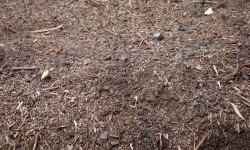
This is the mentioned biochar/compost pile at just a few weeks old. There is a pitchfork in the top right corner of the picture to serve as size reference.
That last quote included from the study by Cheng, hit me like electricity. 70C = 158F. “Wait a second” I thought, 158F is similar to how hot a compost pile gets. Perhaps in a hot, nutrient rich, microbially active compost environment, we could achieve surface oxidation of the biochar itself and also achieve the creation of and subsequent adsorption of carboxylic functional groups (humic and fulvic acids) to the surface of the biochar resulting in a material that has a dramatically improved surface function!!!
Short answer – yes. And other important benefits too. In hindsight, CEC development is important, but we have found other factors such as pH and available nitrogen to be critically important also.
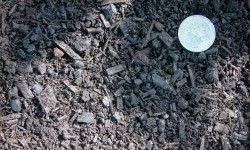
This is the same biochar/compost somewhat finished and screened.
The first attempt beyond bench scale was funded by the above mentioned grant. It was a compost that began with about 20% biochar, 20% manure, and 60% wood chip. The manure was not optimal, the biochar was still in large chunks, and the whole blend went out the door before it was finished. Results were not great, it was N hungry. It was also difficult to market because ended up in a material that wasn’t quite biochar and wasn’t quite compost. Even though the biochar content about doubled by percent as the wood chips and manure decayed, it was just too much extra work to become practical. However, we did succeed at increasing the CEC. Lab analysis of that particular material showed an increase from 34 to 58.
In subsequent experiments we have been successful in creating high quality and economically feasible compost/biochar blends that are majority compost. We have found that the two ends of the spectrum – vast majority biochar or vast majority compost – tend to be the best products, largely due to economics and application rates.
While a dash of biochar in compost is a fantastic way to go, a win-win, the focus of this post is the farthest end of the spectrum in the other direction; how to get the benefits of a compost-like environment with minimal dilution of the biochar.
Mistakes Can Be The Place Of Discovery
While this was going on. I had been experimenting with creating fish hydrolysates with local engineer, Bob Ely. He was eventually successful in getting it right, but one of the first batches of an attempt at fish hydrolysate could, in Bob’s words, “gag a maggot”. So, with my wonderful gift of 2 gallons of “gag-a-maggot” juice, I proceeded home, where upon arrival decided that perhaps a fresh pile of biochar could possibly deodorize the situation. With a plugged nose I released the loathsome liquid upon the char. I threw a shovelful of compost over it then covered the whole mess with more biochar and poked at it a bit. Three days later, upon inspection, odors were detected, but it had turned to sweet earthy smells. And what was really surprising – the pile was hot.
That was 6 years ago.
From Experiments To Products (the first recipes and more)
The first experiments back in 2009 involved the “gag-a-maggot” juice and compost tea that were both on hand for other projects I was working on.
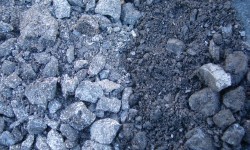
From an early experiment in “biological activation” of biochar materials. The material on left is visibly covered with active microorganisms. 2009
After several months and a series of good, bad, and ugly attempts, we finally honed in on the right set of ingredients and conditions. This is what became the standard biological activation process and recipe for all biochar material sold by my previous company – Hawaii Biochar Products LLC – and still the recipe for Pacific Biochar’s “Cultured, Hawaiian Blend”.
Here is the recipe for “Cultured, Hawaiian Blend”, what I also refer to as Mix #1:
First, moisten biochar to about 50%, then add by volume to biochar:
0.80% Fish, Meat, and Bone Meal (a Hawaiian island product from Island Commodities)
2% Active Compost (produced on-site)
Blend thoroughly.
Allow at least 10 days to “mature”, “culture”, “charge” in a pile, undisturbed.
Harvest in vertical cross sections.
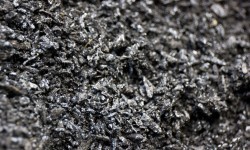
Difficult to capture by camera, the “milky way” is somewhat visible in this picture. There is no direct light, the white highlights are living organisms, not reflective surfaces.
With this recipe – “Mix #1″ – we get temperatures of about 140F to 150F depending on batch size and other variables. The outer layer (about 4″ – 6”), especially when covered, becomes connected by a fungal web, bonding it together in conglomerate pieces that can be picked up gently and will hold their shape. Just inside that layer is a “the milky way”, a layer that appears to be actinomycete dominant, noted by it’s white specks that look star-like against the black background of biochar. The “milky way” has a fading horizon to what appears to be a purely bacteria dominated interior. These layers change in depth and appearance with both age and moisture content. In the first two days, a smell of ammonia is noticeable if the pile is disturbed, this is strongest in the hot interior, but typically undetectable at the surface of an undisturbed pile. It is interesting how quickly this gives way to a sweet earthy smell, beginning at the surface, then usually by day 5, it is sweet and earthy all the way to the core. *Note, a dash too much fish and it will not be sweet and earthy, in fact it will be quite the opposite and may take a month or more to settle down.
Mix #6: This is a very efficient blend. It is simple and effective.

A conglomerated chunk of biologically activated biochar, held together by fungal hyphae.
How we do our Mix #6:
Moisten biochar, then add:
X.XX% Worm Castings
X.XX% Rice Bran
X.XX% Rock Powder
Blend thoroughly.
Allow at least 10 days to “mature”.
(hint: it is still more than 90% biochar by volume)
Dense Mix: This blend strays from the minimalistic nature of the Mix #1 and Mix #6. While Mix #6 also has rock powder, it is only as a supporting role, whereas in the Dense Mix, rock powder takes a lead role. Words and pictures fall short, the feel and smell of the material is phenomenal. We have found this material to hold the most active and diverse microbial population.
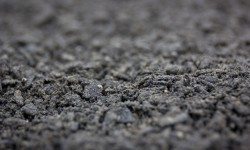
Close up of Dense Mix
How we do our Dense Mix:
Moisten biochar, then add:
X.XX% Rock Powder
X.XX% Rice Bran
X.XX% Worm Castings
Blend thoroughly.
Allow at least 10 days to “mature”.
There are specific details that aren’t shared here. If you try this yourself, you will fail and you will succeed, and in both you will learn. Look to the “How it Works” section below to find guides towards success. Hopefully, you will remember us kindly and share what you have learned. In this fashion, we all move forward.
What Does This Do To The Biochar Materials?
Our biological activation process to improve biochar materials does three critical things among other benefits. It results in a biochar that has:
1.) Dramatically improved surface function, measurable as an increase in CEC.
2.) Improved macronutrient profile, specifically in regards to nitrogen.
3.) A more neutral pH.
At Pacific Biochar, we start with good biochar materials, then we work to improve the biochar materials beyond their original state. While our approach is unique as far as we can tell, there are others that work to accomplish the same basic end result in different ways. For instance, take the below quote from a senior executive of Cool Planet Biofuels, providers of CoolTerra and by far the most highly funded company in the entire biochar industry.
“We start with the IBI requirements and take it a step further by modifying the pore surfaces from the inside out — neutralizing the pH and activating the surfaces resulting in a product with consistently-high performance,†says Rick Wilson, vice-president of CoolTerra Business for Cool Planet.
“We recognized that other biochars required years of aging before consistent performance advantages were realized,†Wilson said. “CoolTerra is different because our technology accelerates natural chemical processes, completing the conversion in 12 minutes.†(excerpt from an article in Western Farm Press, 2.27.15, Laura Pires)
Pacific Biochar’s process takes longer than 12 minutes, it takes about 12 days. But in essence our process accomplishes the same goal, and some would say quite a bit more. We are very proud of our biochar products.
Note: For regulatory purposes we do not claim to have living microorganisms of any particular species or in any particular amount in our products at the time of this writing.
How It Works
We don’t do any of the heavy lifting. We let the tiniest of organisms do that for us. We just feed them. Like grape juice becoming fine wine, we set the stage for the magic of microbes to culture the naked biochar into something more mature.
Rather than adding only nutrients or acids to balance the chemistry of the materials, we add sugars, complex carbohydrates, and/or proteins at just the right amount, then we let the master chemists (microbes) do their “magic”. We have also found that we can guide the reactions not only with our choice of microbial “foods” and conditions such as moisture and pile size, but also with “seasonings” such as minerals, rock powders, clays, and other organic materials.
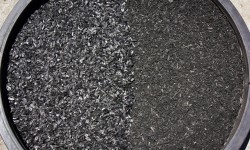
Fresh (left) and “biologically activated” biochar (right)
On the exterior surface and deep within the pores of biochar are some minerals. But other than that it is akin to the surface of the moon. With a sufficient food source and a starting population, a microbial population explosion occurs. Nearly ever surface of the biochar is subjected to colonization in the microbial expansion into unpopulated territory that has either less competition or fresh minerals for use in the microbes growth and health. This can be confirmed under microscope. It is even somewhat visible with the naked eye as the biochar material which was previously a sharply reflective blackish silver, subtly takes on a glossy or matte sheen.
During the digestion of the food source provided, enzymes and organic acids are produced by the microbes present. These organic acids help work to neutralize the pH of the biochar from it’s typically alkaline state towards neutral.
The organic acids created and minerals present help to increase surface function. To use the surface of the moon analogy again; during our natural biological activation process, the surface of biochar becomes much more complex, analogous to the lively and dynamic surface of Earth. Biochar has a naturally high surface area and adsorption capacity, but this adsorption does not alway translate directly into an ability to exchange soil nutrients, particularly cations. Humic acids, minerals, enzymes and other residues created by microbial activity can bond to the surface of biochar, and serve to dramatically increase its function in a soil environment.
The temperature plays a role too. I lack the professorial vocabulary in this area, so I will lean on the original research article that initiated my interest in the topic :
From the Introduction section:
…”Black C [biochar] incubated at both 30 °C and 70 °C [for four months] without microbial activity showed … an increase in cation exchange capacity (CEC at pH 7) by 53% and 538%…”From the Conclusion section:
…”This significant and rapid oxidation may have important implications for the stability of BC since further microbial decomposition may be less constrained by the recalcitrance of aromatic ring structures typical of BC. At the same time, cation retention was significantly enhanced, which would improve soil fertility. This oxidation is sufficiently rapid to make an application of fresh BC to soil feasible in order to enhance crop productivity and decrease potential off-site pollution in agricultural landscapes.”(Cheng et al. 2006)
In short, temperature seems to aid in maturing the biochar materials and aids in developing characteristics which are recognized as valuable in soil.
In Closing
Our Products are the result of years of experimenting. What began as a search for a simple and natural method for “maturing” biochar materials has proved successful. It has also evolved into series of recipes stemming from the same basic process, all of which show improved characteristics and yield incredible results.
We continue to experiment. If you are interested to try our products, I invite you to visit our Products page to see what is available. Feel free to Contact Us to request a quote.
Are you interested in research? So are we. If you have a project that seems fitting, Contact Us to discuss opportunities.
Sincerely,
– Josiah Shelton Hunt
Bibliography:
Oxidation of Black Carbon by Biotic and Abiotic Processes, , Organic Geochemistry, Volume 37, p.1477-1488, (2006)
Black Carbon Increases Cation Exchange Capacity in Soils, , Soil Science Society of America Journal, Volume 70, p.1719-1730, (2006)
Maize yield and nutrition during 4 years after biochar application to a Colombian savanna oxisol , , Plant and Soil, 03/2010, (2010)

